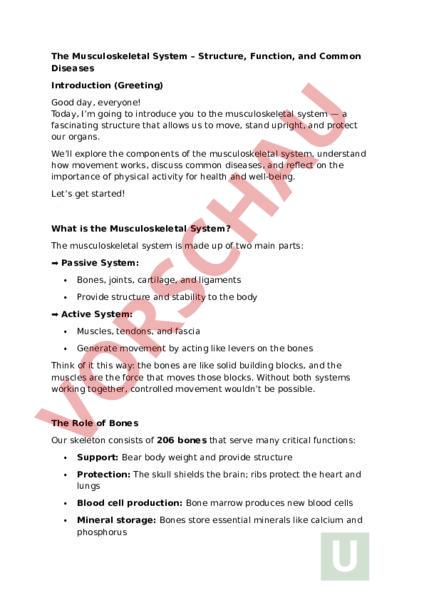Arbeitsblatt: English
Material-Details
THe Muscle System
Englisch
Anderes Thema
7. Schuljahr
1 Seiten
Statistik
212461
32
0
23.03.2025
Autor/in
Karthika Jijin
Land: Schweiz
Registriert vor 2006
Textauszüge aus dem Inhalt:
The Musculoskeletal System – Structure, Function, and Common Diseases Introduction (Greeting) Good day, everyone! Today, Im going to introduce you to the musculoskeletal system — fascinating structure that allows us to move, stand upright, and protect our organs. Well explore the components of the musculoskeletal system, understand how movement works, discuss common diseases, and reflect on the importance of physical activity for health and well-being. Lets get started! What is the Musculoskeletal System? The musculoskeletal system is made up of two main parts: Passive System: Bones, joints, cartilage, and ligaments Provide structure and stability to the body Active System: Muscles, tendons, and fascia Generate movement by acting like levers on the bones Think of it this way: the bones are like solid building blocks, and the muscles are the force that moves those blocks. Without both systems working together, controlled movement wouldnt be possible. The Role of Bones Our skeleton consists of 206 bones that serve many critical functions: Support: Bear body weight and provide structure Protection: The skull shields the brain; ribs protect the heart and lungs Blood cell production: Bone marrow produces new blood cells Mineral storage: Bones store essential minerals like calcium and phosphorus strong skeleton is essential for movement and overall health! Muscles – The Engines of Movement The body has over 600 muscles, making up about 40% of body weight. They come in three types: Skeletal muscles: Voluntary muscles that move the limbs and trunk Smooth muscles: Involuntary muscles in organs (like the digestive system) Cardiac muscle: The unique muscle that pumps blood through the heart When we move, one muscle contracts while its opposing muscle relaxes. For example, when bending the arm, the biceps contract, and the triceps stretch. This movement happens because the muscle pulls on the bone through the tendon. Joints, Tendons, and Ligaments Smooth, controlled movement wouldnt be possible without joints, tendons, and ligaments: Joints: Connect bones and allow different types of movement Ball-and-socket joints (shoulder): Wide range of motion Hinge joints (knee): Movement in one direction Pivot joints (neck): Allow rotation Tendons: Connect muscles to bones and transmit force Ligaments: Stabilize joints and prevent overextension or dislocation In short: Joints provide mobility, tendons transmit force, and ligaments add stability! How Movement Works Movement is the result of complex interaction between the brain, nerves, muscles, and bones: 1. The brain sends an electrical impulse through the nerves to the muscles 2. The muscle contracts, pulling on the bone through the tendon 3. The bone moves within the joint, creating movement Example — Walking: Leg muscles contract to pull the bones, knee joints bend and extend, and ligaments keep the knee stable to prevent falls. Common Diseases of the Musculoskeletal System Unfortunately, the musculoskeletal system is prone to diseases that can limit mobility and affect quality of life. Lets look at some common conditions:
